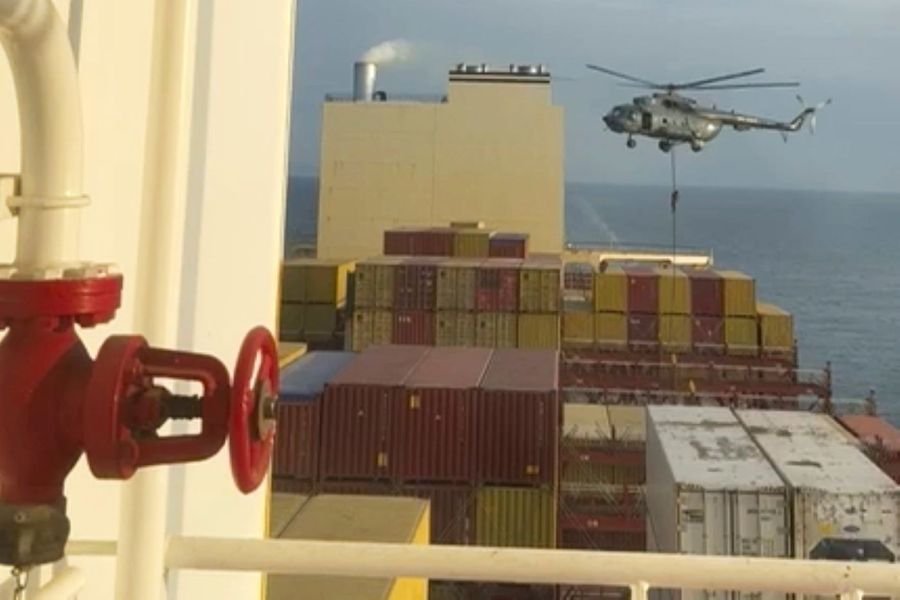
Economic fallout from the weekend strike by U.S. forces on Iranian nuclear facilities has been muted so far, but the opening of direct hostilities between the U.S. and Iran could have far-reaching consequences for the global economy.
Shipping rates have spiked, oil prices are rising, and global stock markets have taken a hit.
All eyes are on the Strait of Hormuz, the narrow channel between the Arabian Peninsula and the Iranian mainland through which 20 million barrels of petroleum transit every day. That is the equivalent of 20 percent of the world’s daily petroleum consumption.
Iran’s Parliament approved a measure to close the Strait, according to a report from Iranian broadcaster Press TV, citing Iranian lawmaker Esmaeil Kowsari.
The channel lies entirely within the territorial waters of Iran and Oman, and attempts to close it could result in a dramatic escalation of the conflict.
Rising energy and shipping costs could translate to higher prices globally. Prices in the U.S. are already under pressure from President Trump’s trade war and are expected to rise this summer. Tariffs have yet to make a big impact on consumer prices overall.
Here’s a look at the economic dimension of the conflict so far.
Markets cautiously optimistic after Iranian restraint
U.S. stock markets rallied in early trading Monday as Iran had at that point confined its military response to missile attacks on Israel. Israel and Iran had been exchanging rocket volleys through last week after Israel took the unprecedented step of launching a direct attack on Iran on June 13 with Operation Rising Lion.
The Dow Jones Industrial Average of big U.S. stocks jumped 200 points, or about half a percent, while the S&P 500 index was up more than 32 points, or about 0.55 percent, in trading Monday morning.
The technology-heavy Nasdaq composite made a similar jump of 0.55 percent above an index level of 19,550.
European indices were broadly down, with the French CAC 40, the German DAX and the British FTSE 100 all seeing losses. The Shanghai Composite index was up 21 points or 0.65 percent.
U.S. looks to China for help on Hormuz
U.S. Secretary of State Marco Rubio said over the weekend that he wants China to put pressure on Iran to keep the Strait of Hormuz open.
About 84 percent of the oil and 83 percent of the natural gas that went through Hormuz in 2024 went to Asian markets, according to the U.S. Energy Information Administration, with China, India, Japan and South Korea as the top consuming countries.
“I would encourage the Chinese government in Beijing to call [Iran] about that, because they heavily depend on the Straits of Hormuz for their oil,” Rubio said.
He added that closing Hormuz would amount to “economic suicide” for Iran. Analysts for Deutsche Bank noted Monday that the majority of Iran’s oil exports in the back half of 2024 went to China directly.
The Iranian Parliament was reported to have approved the strait’s closure, but the final decision rests with Iran’s Supreme National Security Council, Iran’s Press TV reported Sunday.
While China said the U.S. attack harms American credibility and put forward a resolution at the United Nations Security Council calling for an immediate ceasefire, Chinese officials on Monday stressed the importance of the shipping route for international commerce.
“Keeping the region safe and stable serves the common interests of the international community,” Foreign Ministry spokesperson Guo Jiakun told reporters. “China calls on the international community to step up effort to promote de-escalation of the conflict, and prevent the regional turmoil from having a greater impact on global economic growth.”
Russian President Vladimir Putin described the U.S. attack as “absolutely unprovoked aggression against Iran,” saying it has “no justification whatsoever.”
Qatar closed its airspace on Monday because of safety concerns, Saudi Arabian broadcaster Al Arabiya reported Monday.
Iran launched a missile attack against U.S. forces stationed at Al Udeid Air Base in Qatar on Monday, according to media reports. Blasts were heard over the capital, but there were no reported casualties.
Energy prices are climbing
Even as the Strait of Hormuz remains open, oil and gas prices are rising, as they have been since Israel’s initial attack on June 13.
West Texas Intermediate (WTI) crude oil futures climbed in morning trading but were even as of noon on Monday at $73.81 per barrel. Brent crude was up 0.65 percent on the day to $72.75 a barrel.
Both WTI and Brent are up close to 10 percent since the first Israeli strikes earlier this month.
Energy price spikes could translate into price increases in consumer goods, both in the U.S. and globally. Energy prices had been falling prior to the conflict and specifically since early April, when President Trump’s “reciprocal” tariffs were announced.
While oil prices fell back after the Iranian attack on the U.S. base in Qatar, energy prices are likely to be volatile throughout the conflict.
“The US is self-sufficient in energy … but the US does import oil and petroleum products from many countries, including the Persian Gulf,” ING international economist James Knightley wrote in a Monday commentary.
“Higher gasoline prices would intensify the strain on consumer pockets, risking a more pronounced slowdown in the economy,” he added.
In a Monday social media post, Trump made a general call for stable oil prices.
“EVERYONE, KEEP OIL PRICES DOWN. I’M WATCHING! YOU’RE PLAYING RIGHT INTO THE HANDS OF THE ENEMY. DON’T DO IT!” Trump said on Truth Social.
Shipping rates are also climbing
The Baltic Exchange Dirty Tanker index was up 1.35 percent on Monday to $1,054.
Rates for oil tankers surged about 50 percent on the Worldscale global index to about 75 points, logistics trade publication FreightWaves reported Monday.
Charter prices for large crude oil carriers from the Middle East Gulf to China jumped from about $20,000 a day to close to $50,000 last week, the Financial Times reported, citing figures from Clarksons Research.
Shipping giant Maersk said Monday that ships are transiting through Hormuz, but they have backup plans in place in case the channel is closed.
“At the moment, we continue to deem sailing through the Strait of Hormuz possible, but we monitor the situation closely and have contingency plans in place should the situation change in the near future,” the company said in a statement.
Various pipelines in the Gulf can bypass the Strait of Hormuz if it’s shut.
The U.S. Energy Information Administration estimates that 2.6 million barrels per day of pipelines capacity through Saudi Arabia and the United Arab Emirates could be made available in the event of a closure.
Other commodities show signs of stress
Prices for other commodities have shown volatility in response to the fighting in the Middle East as well.
Wheat prices shot up after the Israeli attack on Iran but were down more than 2.3 percent in Monday trading of the Chicago SRW wheat futures index.
Soybean futures were down more than 1.4 percent Monday after spiking earlier this month.
Gold prices were up 0.35 percent in Monday trading, continuing an upward trend over the past year and a hard upward spike in April prompted by tariffs.
The dollar strengthened in response to the hostilities but has been declining somewhat sharply relative to other currencies since the beginning of the year. The DXY dollar-to-global currencies index is down about 10 percent since January, and saw hard drops in March and April following tariff announcements.


